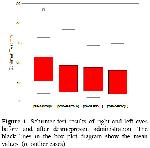Lacrimal aqueous secretion is divided into basal secretion which is maintained by the accessory exocrine glands of Krause and Wolfring and reflex secretion which is maintained by the main lacrimal gland
5. But recent studies showed that the main and accessory lacrimal glands routinely work simultaneously with one another
6.
The Schirmer test is a test of tear volume and also measures the volume of tear produced during a fixed period of time 4,5. Schirmer test without topical anesthesia measures the reflex secretion mainly maintained by main lacrimal gland. The Schirmer test with topical anesthesia eliminates the reflex tearing produced by irritation from the Schirmer strip and that wetting of the strip represents the basal tear secretion. This basal aqueous secretion mainly maintained by accessory lacrimal glands Krause and Wolfring.
Repeatability of the Schirmer test is more variable 7. So we repeated the Schirmer test measurements for three consecutive days and the mean values of Schirmer tests were taken for statistical analysis.
The results of this study showed that desmopressin reduced the main and accessory lacrimal glands aqueous secretion but only main lacrimal gland aqueous secretion reduction was statistically significant (p: 0.001).
Lacrimal glands aqueous secretion is controlled by autonomous nervous system and sex hormones. Parasympathetic fibers 8 and β1- adrenergic agonists 9 stimulate lacrimal aqueous secretion. The presence of beta 1 receptors in the accessory lacrimal glands had also shown 10. Sex hormones also have important role in secretory function 11 and morphological appearance 12 of the main lacrimal gland. This means lacrimal glands also influenced from the hormonal status. Vasopressin is also hormone so can influence the secretory functions of lacrimal glands.
The presence of vasopressin in the lacrimal gland of the rat has been documented immunohisto-chemically 13. But in the available literature we could not find any knowledge about the effect of vasopressin on human lacrimal gland functions. As a preliminary study we used desmopressin instead of vasopressin because the drug can be administered intranasally without an invasion and it mimics the anti-diuretic properties of vasopressin 3.
Antihistamines, antianxiety agents, and tricyclic antidepressants decrease the lacrimal glands aqueous secretion 14. These drugs cause dry eye symptoms via their anti-cholinergic actions. In sera of primary Sjogren syndrome patients autoantibodies against muscarinic acetylcholine receptors was found and may be considered among the serum factors implicated in the pathophysiology of the development of dry eyes 15.
In our preliminary study we showed that desmopressin decreases the lacrimal glands aqueous secretion. But further studies are needed to identify the mechanism of vasopressin effect on lacrimal glands. If this mechanism is identified local vasopressin receptor antagonists may have a possible role in the treatment of dry eye.



